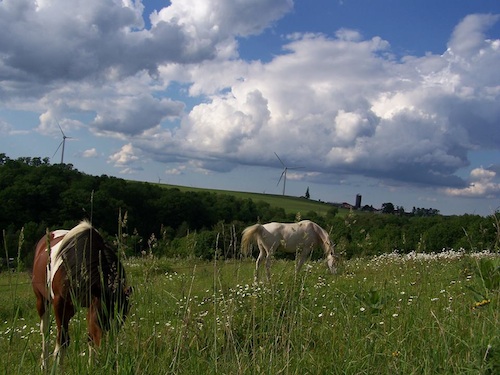Fact check: Lomborg errs on cost of wind power
While Mr. Lomborg manages to works in a few gems like “The switch to fossil fuels has also had tremendous environmental benefits.” and “Coal saved Europe’s forests,” the reality is that, thanks to massive cost reductions, wind energy is already making important contributions to solving our environmental problems. Wind power has accounted for more than 35 percent of all newly installed electric capacity in the U.S. over the last five years, and renewables combined were 55 percent of all new capacity in 2012.
Wind now reliably provides more than 20 percent of the electricity in Iowa and South Dakota and more than 12 percent in nine states, according to the Department of Energy. The amount of wind power installed in the U.S. today reduces CO2 emissions by almost 100 million tons per year–equivalent to taking 17 million cars off the road.

This rapid deployment of wind energy has occurred because costs have already fallen precipitously. Importantly, deployment, not research and development, has been the leading driver of these cost reductions.
In fact, wind power costs have declined more than 50 percent in the last four years, according to the 2013 annual report from leading financial services firm Lazard. The Department of Energy similarly concluded that “With [wind’s] combination of lower prices and improved performance, wind is becoming a strong competitor."
A key driver of these cost reductions has been the creation of a domestic wind turbine manufacturing sector that now builds over 70 percent of a wind turbine’s value in the USA.
In a virtuous circle, policies that successfully encourage private sector deployment of wind energy have greatly driven down wind energy costs, enabling further deployment, which further brings down costs, etc. Calls for policymakers to switch from the meager policies that deploy wind energy to instead investing in research and development sound like a desperate effort to ensure that we take our foot off the gas pedal just as we are about to reach the clean energy future that we so urgently need.
In his piece, Mr. Lomborg repeatedly attempts to lump modern renewables like wind and solar in with prehistoric energy sources like burning firewood for heat. That allows him to point to underdeveloped regions and make ridiculous arguments like “The most renewables-intensive places in the world are also the poorest.”
(Incidentally, a few paragraphs later, Mr. Lomborg acknowledges that wind energy supplies 34 percent of Denmark's electricity, though he doesn’t offer an explanation as to how Denmark and other wealthy European countries that obtain more than 15 percent of their electricity from wind energy fit into his theory about the relationship between wealth and renewable use.)
Finally, Mr. Lomborg conveniently overlooks the far larger subsidies given to other energy sources, which are particularly large when one looks historically and globally. According to the Congressional Research Service, “For more than half a century, federal energy tax policy focused almost exclusively on increasing domestic oil and gas reserves and production. A report by DBL Investors also found that in “inflation-adjusted dollars, nuclear spending averaged $3.3 billion over the first 15 years of subsidy life, and O&G subsidies averaged $1.8 billion, while renewables averaged less than $0.4 billion.” Even by the Nuclear Energy Institute’s own count, fossil and nuclear subsidies are many times larger than the total amount given to all renewables over the last 60 years
Internationally, the International Energy Agency estimated that, in 2011 alone, global fossil fuel direct subsidies were worth $523 billion, compared to $88 billion for all renewables. Earlier this year, the International Monetary Fund reported that global subsidies to fossil fuels are a staggering $1.9 trillion a year, including about $500 billion in direct subsidies as well as more than $1 trillion more provided by a lack of policies to account for the costs of pollution.
Bottom line: like all energy industries, the wind industry needs stable policies to continue to grow and further bring down its costs, keeping us on the path to a low-cost, clean energy future.
Photo credit: First Wind – Cohocton Wind Project
UPDATE [30 August 2013, 9:50 a.m.]: A previous version of this post referred to Mr. Lomborg as a "climate change denier." That description was based upon Mr. Lomborg’s discredited claim in his book The Skeptical Environmentalist that variations in cosmic radiation were a significant driver of observed climate change in recent years, and later claims that climate change was not a major threat. Mr. Lomborg has asked for a correction of the description, and recently tweeted, "@AWEA Cool It: Global warming is real and man-made. It will have a serious impact on humans & the environment toward end of this century." With that in mind, the wording has been changed to "former climate change denier." More information on the evolution of Mr. Lomborg's views is available here, here and here.
Related articles:
The top 5 signs that wind is becoming America's most affordable energy choice, August 28, 2013
Across country, editorials spread good news on wind power, August 26, 2013
U.S. Department of Energy report: Wind power costs near record low, August 6, 2013
Wall Street Journal highlights cost competitiveness of new wind projects, August 1, 2013
Citing low costs, Xcel Energy plans 'significant increase' in wind purchases, July 11, 2013
DNV KEMA: Accuracy of wind farm energy assessments improving, July 9, 2013
President's speech highlights wind power's benefits for both 'red' and 'blue' states, July 5, 2013
Wind tax credits a no-cost way to avoid greenhouse gas emissions, June 20, 2013
Fact check: Exelon's faulty math (and logic) on wind's consumer benefits, June 11, 2013
Mid-American Energy announces $1.9-billion investment in additional wind generation capacity, May 8, 2013
WINDPOWER 2013 Update: Analysts see future market of 4-8 GW/year in U.S., May 7, 2013
Georgia Power to acquire 250 MW of wind; utility underscores strategy of portfolio diversity, April 29, 2013
Buffalo Dunes Wind Project: A lesson in export, affordability, and transmission, April 23, 2013
Fact check: Attack by Locke Foundation's Sanders on N.C. RPS relies on flawed data, April 3, 2013
Fact check: Tang Energy's Jenevein off target with swipes at wind power, April 2, 2013
LBNL report: Low natural gas prices haven't detracted from wind's hedge appeal, March 11, 2013
[Press release] U.S. electric utilities flock to lower-priced wind power, February 20, 2013
Fact check: Pacific Research Institute report by Benjamin Zycher filled with inaccuracies, January 28, 2013
Fact check: Marshall Institute attacks wind power, ignores facts, January 15, 2013
Fact check: Study on turbine lifespan 'just more anti-wind propaganda', December 24, 2012
Fact check: American Tradition Institute's Taylor and Tanton blowing smoke on wind incentive, December 20, 2012
TVA named 'Utility of Year' for pioneering wind power in Southeast, December 3, 2012
AWEA honors Alabama Power for using wind power to save dollars for Southeastern customers, December 3, 2012





